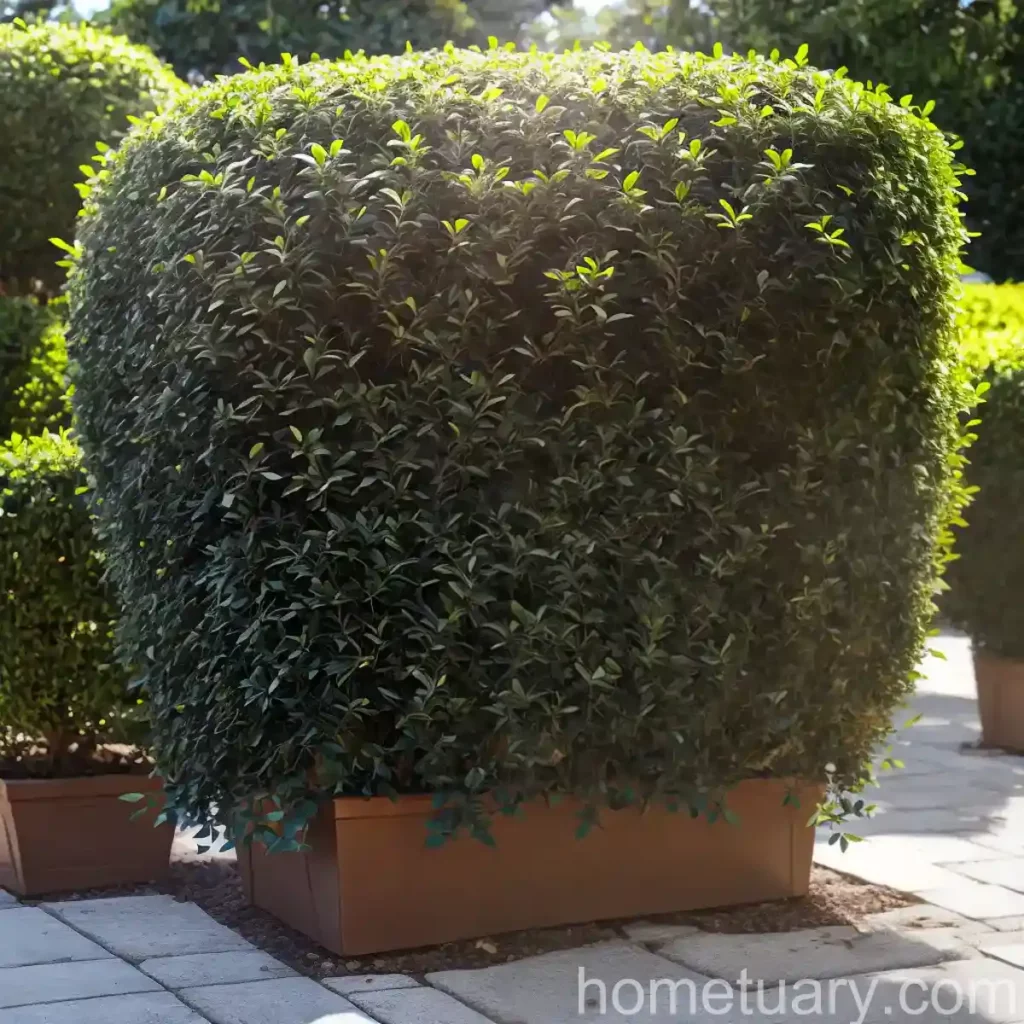The Fascinating World of Common Privet (Ligustrum vulgare)
As a plant scientist, I am enamored by the astounding diversity and beauty of the plant kingdom. One particularly captivating member of this kingdom is the common privet, scientifically known as Ligustrum vulgare. This versatile shrub offers not only aesthetic appeal but also a range of practical uses, making it a valuable addition to gardens and landscapes.
In this comprehensive guide, we will delve into the captivating world of the common privet, exploring its cultural significance, practical uses, growth requirements, common diseases and pests, propagation techniques, and much more.
What is the Common Privet (Ligustrum vulgare)?
The common privet, or Ligustrum vulgare, is a species of flowering plant belonging to the olive family, Oleaceae. This deciduous or semi-evergreen shrub is native to the European continent and Western Asia. It has naturalized in various regions worldwide and is known for its adaptability and resilience.
The common privet is renowned for its dense foliage, which often forms impenetrable hedges. Its small, white, fragrant flowers and dark berries add to its ornamental appeal, making it a popular choice in landscaping and gardens.
Key Takeaways – Common Privet (Ligustrum vulgare)
Before we delve deeper into the fascinating world of the common privet, let’s take a quick look at some key takeaways:
- Plant Name: Common Privet (Ligustrum vulgare)
- Common Names: Wild Privet, European Privet
- Family: Oleaceae
- Native Range: Europe, Western Asia
- Foliage: Deciduous to Semi-evergreen
- Flowers: Small, White, Fragrant
- Berries: Dark colored
- Cultural Significance: Ornamental, Privacy Hedges
- Practical Uses: Hedge Plant, Medicinal Properties, Wildlife Habitat
Now, let’s embark on a journey to uncover the intriguing aspects of this remarkable plant, from its cultural significance to its growth requirements and ecological importance.
Cultural Significance of Common Privet (Ligustrum vulgare)
Uses
The common privet has been cherished for centuries for its multitude of uses, ranging from practical applications to its ornamental value.
Ornamental Purposes
One of the most common uses of the common privet is its ornamental appeal in gardens and landscapes. Its dense foliage and ability to form neat hedges make it a preferred choice for creating privacy screens, borders, and defining spaces within a garden. Additionally, its fragrant flowers and dark berries add visual interest, especially during the flowering and fruiting seasons.
Medicinal Properties
Beyond its ornamental value, the common privet has been traditionally used in herbal medicine for its purported health benefits. The leaves, bark, and berries of the plant have been utilized in traditional remedies for conditions such as respiratory ailments, skin disorders, and digestive issues. However, it is crucial to note that the medicinal uses of the common privet should be approached with caution, as certain parts of the plant contain compounds that can be toxic if ingested in large quantities.
Water
When it comes to watering the common privet, it is essential to strike a balance to promote healthy growth and avoid waterlogging. Here are some key points to consider:
- Established Plants: Once established, common privets are generally drought-tolerant and can withstand dry spells. However, adequate watering is crucial during the initial establishment period to promote healthy root development.
- Watering Frequency: Water newly planted common privets regularly, aiming for deep, thorough watering to encourage deep root growth. During periods of prolonged drought, provide supplemental irrigation to prevent stress and maintain vitality.
Sunlight
The common privet thrives in locations with ample sunlight, although it can also tolerate partial shade. Here are some sunlight considerations for this versatile shrub:
- Full Sun: Ideally, plant common privet in areas that receive full sunlight for a significant portion of the day. This will promote robust growth, abundant flowering, and dense foliage.
- Partial Shade: While common privets prefer full sun, they can also adapt to partial shade conditions. In regions with intense summer heat, providing some afternoon shade can be beneficial to prevent leaf scorch and maintain overall health.
Fertilizer
Proper fertilization is essential for promoting healthy growth and robust foliage in common privets. Consider the following guidelines for fertilizing these versatile shrubs:
- Balanced Fertilizer: Use a balanced, slow-release fertilizer designed for shrubs and hedges to provide essential nutrients without promoting excessive vegetative growth.
- Fertilizing Schedule: Apply fertilizer in early spring before the onset of new growth, and consider a second application in late spring if necessary. Avoid excessive fertilization, as it can lead to weak, leggy growth and increased susceptibility to pests and diseases.
Soil
The common privet is relatively adaptable when it comes to soil conditions, but certain considerations can ensure optimal growth and vitality.
- Well-draining Soil: Plant common privets in well-draining soil to prevent waterlogging and root rot. Amending heavy clay soils with organic matter can improve drainage and promote healthy root development.
- Soil pH: The ideal soil pH for common privets is slightly acidic to neutral (pH 6.5-7.5). Conduct a soil test to determine the current pH levels and make adjustments as needed to create an optimal growing environment.
Pruning
Proper pruning is essential for shaping common privets, maintaining their desired size, and promoting dense foliage. Here are some key considerations for pruning these versatile shrubs:
- Pruning Frequency: Common privets benefit from regular pruning to control their size and shape. Consider performing major pruning in late winter or early spring before the onset of new growth, with light maintenance pruning as needed throughout the growing season.
- Pruning Techniques: When pruning common privets, focus on removing dead or damaged branches, shaping the overall form, and thinning out crowded growth to improve airflow and light penetration.
Propagation
Propagating common privets can be an exciting and rewarding endeavor, allowing you to expand your garden or landscape without relying solely on nursery-bought plants. Here are some common propagation methods for the versatile common privet:
- Seed Propagation: Collect mature berries from healthy common privet plants and carefully remove the seeds. Sow the seeds in seed-starting trays filled with well-draining potting mix, and provide consistent moisture and warmth to encourage germination. Transplant the seedlings once they have established sturdy root systems.
- Softwood Cuttings: Take softwood cuttings from healthy, vigorously growing common privet plants in early summer. Dip the cut ends in a rooting hormone, and place the cuttings in a well-draining propagation medium. Provide consistent moisture and humidity to encourage root development, and transplant the rooted cuttings once they are established.
Container Popularity
In addition to being a popular choice for landscape hedges and garden borders, common privets can also thrive in containers, making them versatile options for patios, balconies, and urban gardens. Here are some key considerations for growing common privets in containers:
- Container Size: Select a spacious container that provides ample room for the common privet’s root system to thrive. Ensure that the container has drainage holes to prevent waterlogging.
- Well-draining Potting Mix: Use a high-quality, well-draining potting mix to provide optimal growing conditions for common privets in containers. Avoid compacted or water-retentive soils that can impede root respiration.
Common Diseases of the Common Privet (Ligustrum vulgare)
While the common privet is relatively resilient to many environmental stressors and pests, it can be susceptible to certain diseases that can impact its health and vitality. Understanding common privet diseases and their diagnosis is crucial for implementing effective management strategies and maintaining the overall well-being of these versatile shrubs.
Disease Diagnosis
It is essential to be vigilant and observant when monitoring the health of common privets, as early detection of disease symptoms can be instrumental in implementing timely interventions. Here are some common diseases of the common privet and their diagnostic characteristics:
- Leaf Spot: Symptoms include the development of dark, irregular spots on the leaves, often surrounded by yellow halos. Leaf spot can be caused by various fungi and bacteria and is often promoted by prolonged leaf wetness and high humidity.
- Root Rot: Root rot can be caused by various soil-borne pathogens, leading to the decline of the plant’s overall health. Symptoms include wilting, yellowing, and eventual dieback of the foliage, often accompanied by a foul odor and dark, mushy roots.
- Powdery Mildew: Powdery mildew is characterized by the presence of a white, powdery growth on the surfaces of leaves, stems, and occasionally flowers. This fungal disease thrives in humid conditions and can lead to stunted growth and reduced aesthetic appeal.
- Anthracnose: Anthracnose can cause the development of dark, sunken lesions on the leaves and stems of common privets. In severe cases, it can lead to defoliation and weakened overall health.
Common Pests
In addition to diseases, common privets can also be affected by certain pests that can impact their growth and vitality. Understanding common privet pests and their management is essential for maintaining the health and vigor of these versatile shrubs.
Botanist’s Tips
As a plant scientist with a deep appreciation for the natural world, I have gathered valuable insights and practical tips for cultivating and caring for common privets. Here are some essential botanist’s tips for achieving success with common privets in your garden or landscape:
- Promote Biodiversity: While common privets offer practical benefits as hedges and ornamental shrubs, consider integrating diverse plant species to create a balanced and thriving ecosystem. Incorporating native plants, flowering species, and habitat-providing plants can attract beneficial insects, pollinators, and wildlife.
- Practice Integrated Pest Management: Instead of relying solely on chemical controls, consider implementing integrated pest management (IPM) strategies to manage pests and diseases in an environmentally responsible manner. This approach involves the use of cultural, biological, and mechanical controls alongside targeted pesticide applications when necessary.
- Observe Local Regulations: Before planting common privets or implementing landscape changes, familiarize yourself with local regulations, ordinances, and invasive species lists. In some regions, common privets may be considered invasive and may pose a threat to native ecosystems if not properly managed.
- Support Wildlife: Common privets can provide valuable habitat and food sources for birds, insects, and small mammals. Consider integrating wildlife-friendly plants and features into your landscape to create a biodiverse and vibrant environment.
Fun Facts
Before concluding this comprehensive guide, let’s uncover some fascinating fun facts about common privets that showcase the remarkable attributes of this versatile shrub:
- Wildlife Habitat: Common privets serve as valuable habitat and food sources for a variety of wildlife, including birds and small mammals. Their dense foliage and berries provide shelter and sustenance, contributing to local biodiversity.
- Cultural Significance: In some cultures, common privets are associated with symbolism and traditional beliefs. They have been linked to concepts such as resilience, protection, and boundary delineation.
- Fragrant Flowers: The small, white flowers of the common privet emit a delightful, sweet fragrance, attracting pollinators and adding an olfactory dimension to gardens and natural settings.
- Invasive Potential: While common privets have been widely utilized in landscaping, they can also naturalize and become invasive in certain regions. It is crucial to prevent their escape into natural habitats and to manage their growth responsibly.
Links to External Resources
To further enrich your understanding of common privets and their cultivation, I recommend exploring the following external resources:
- The Royal Horticultural Society – Common Privet
- University of Florida IFAS Extension – Ligustrum vulgare Fact Sheet
- USDA Forest Service – Ligustrum vulgare Species Profile
- Missouri Botanical Garden – Ligustrum vulgare Plant Profile
In conclusion, the common privet (Ligustrum vulgare) stands as a remarkable example of a plant species that seamlessly blends practical utility with ornamental charm. As you embark on your journey of cultivating and appreciating common privets, may these insights and tips serve as valuable companions, guiding you toward success and a deeper connection with this captivating shrub.
Whether you seek to create lush privacy hedges, support local wildlife, or simply revel in the beauty of nature, the common privet offers a wealth of possibilities and enriching experiences. Embrace the diversity of the plant kingdom and the captivating allure of the common privet as you nurture and celebrate the natural world around you.















